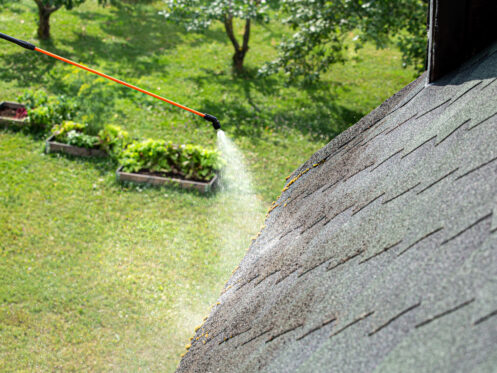Your roof is your home’s first line of defense against the elements, but it doesn’t last forever. Moisture, poor ventilation, and hidden leaks can all lead to a serious issue—roof rot. The problem is roof rot doesn’t always make itself obvious until the damage is extensive. Soft spots, dark stains, and a musty attic smell could be early warning signs. If left unchecked, rot can weaken your roof’s structure, leading to costly repairs and, in severe cases, a full replacement. Fraser Roofing, LLC in Atlanta, GA, is here to help you recognize potential issues early and take action before they turn into costly repairs.
What Causes Roof Rot?
Roof rot happens when moisture gets trapped in your roof, causing the wood to break down. This usually starts when water sneaks in through small leaks, missing shingles, or bad ventilation. Once the wood gets wet, it’s weak and a great place for fungi to grow and spread.
A big cause of roof rot is poor attic ventilation. Warm air from inside your home naturally rises, but if it has nowhere to go, it gets stuck in the attic. This leads to condensation, which soaks into the rafters and plywood. This condensation becomes water, and if you leave it there for too long, your roof becomes less stable, increasing the chances that it will sag, leak, or rot.
Clogged gutters can also be a problem. If rainwater can’t drain properly, it backs up under the roof’s edge, soaking into the decking and causing it to break down. If you don’t fix the issue quickly, even minute volumes of standing water may cause major issues.
How to Spot Early Signs of Roof Rot
One hard thing about roof rot is that it often starts to show up where you can’t see it. The harm might already be considerable by the time it becomes clear. Knowing what to search for can prevent costly repairs.
Inside your home, one of the first signs might be a musty smell in the attic or upstairs rooms. This odor comes from damp wood breaking down and can be an early clue that moisture is building up where it shouldn’t be. You might also notice water stains on your ceiling or walls, which could mean water is seeping through weak spots in the roof.
Outside, look for sagging areas, especially along the edges of the roof. If parts of your roof appear uneven or wavy, the underlying wood could be softening. Because dark patches or moss growth often hold onto water longer than the surrounding regions, they might also point to retained moisture.
If you have asphalt shingles, check for curling or missing pieces. Shingles are designed to protect the roof’s structure from water, but once they’re damaged, moisture can work its way inside.
Role of Poor Ventilation in Roof Rot
Good airflow in the attic keeps moisture from building up, but if air gets trapped, condensation forms under the roof. That moisture soaks into the wood, making it weak and setting the stage for rot.
One way to tell if your attic has ventilation issues is to check for excessive heat. If your attic feels very hot in the summer or damp when it’s cooler, there might not be enough airflow. Another sign is frost in winter. When warm air hits cold surfaces, it turns to frost. This frost then melts and drips onto the wood, making rot happen faster.
Improving attic ventilation usually involves adding or clearing out vents along the eaves and roof ridges. Vents and attic fans work together to keep air moving, drying out the space and stopping moisture from soaking into the wood.
How Rain and Snow Contribute to Roof Rot
Rain in the spring and fall can show you where your roof is weak. After a while, the wood underneath will start to break down if water pools in some places or drips through cracks. Even small leaks can create a long-term moisture problem that leads to rot.
Snow adds another challenge. When snow sits on your roof, its weight alone can stress the structure. But the bigger issue is the freeze-thaw cycle. The roof turns snow into water when the sun comes out. The water then freezes again at night. As materials expand and contract, water gets pushed into tiny cracks, making them larger and more likely to leak.
Ice dams can also be a major problem in colder months. When heat escapes from the attic, it melts the bottom layer of snow on the roof, sending water down toward the eaves. Since the edges of the roof are colder, the water refreezes, creating a thick ridge of ice. This dam prevents additional melting snow from draining properly, trapping water against the roof and increasing the risk of leaks and rot.
Keeping gutters clear and making sure attic insulation is evenly distributed can help prevent these seasonal issues. Proper drainage and balanced temperatures go a long way in protecting your roof from moisture damage.
Why You Shouldn’t Ignore a Small Leak
A tiny leak might not seem like a big deal, but even a slow drip can lead to major structural problems. When moisture seeps into your attic, it can ruin insulation, making it less effective and driving up energy costs. Damp insulation also becomes a hotspot for mold, which spreads fast and impacts your home’s air quality.
Over time, a small leak can weaken wooden beams and decking, causing them to warp or sag. If left unchecked, the damage can extend to your ceiling, walls, and even electrical systems. Water spots or paint that is peeling off might be the first things you see inside your home. However, by the time you notice these, the damage may already be pretty bad.
Addressing leaks as soon as you spot them can prevent costly repairs down the road. A simple patch job today could save you from replacing large sections of your roof later.
Importance of Regular Roof Inspections
A lot of people don’t think about their roofs until something goes wrong, but regular checks can find problems before they become big problems. Roofers performing a professional inspection will look for weak spots, missing shingles, and early signs of rot that might not be obvious from the ground.
A good time to schedule an inspection is in the spring after winter’s heavy snow and ice have had a chance to take their toll. Roofers will check for loose flashing, cracked sealants, and damaged shingles that could create leaks. They will also evaluate insulation and ventilation to ensure everything is cooperating to control dampness. A roof check in the fall helps get it ready for winter by making sure gutters are clear and water can drain properly.
Keep Your Roof in Top Shape
Keeping your roof in good shape is easier than you think! Clean the gutters, check for missing shingles, and make sure your attic gets plenty of fresh air. If you spot musty smells, water stains, or sagging spots, don’t ignore them. Regular checkups and quick roof repairs help your roof stay strong and dry for years.
Fix Your Roof Rot
Ignoring roof rot won’t make it go away. The sooner you spot the signs and take action, the better chance you have at preventing major damage. Whether it’s a small repair or a full roof inspection, the experts at Fraser Roofing, LLC are here to help. Contact us today, and let’s make sure your roof stays strong for years to come.

